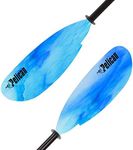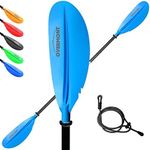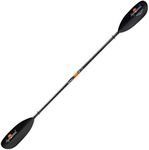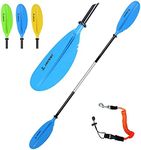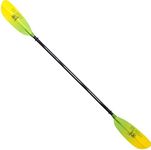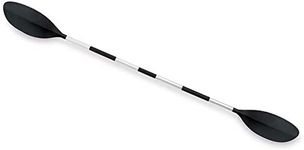Buying Guide for the Best Lightest Kayak Paddle
Choosing the right kayak paddle is essential for a comfortable and enjoyable paddling experience. The lightest kayak paddle can make a big difference, especially if you plan to spend long hours on the water. A lighter paddle reduces fatigue, helps you maintain a steady rhythm, and can even improve your overall performance. When picking a paddle, it's important to consider not just the weight, but also how the paddle feels in your hands, its length, blade shape, and the materials used. Understanding these key specifications will help you find a paddle that matches your paddling style and physical needs.WeightThe weight of a kayak paddle refers to how heavy the paddle feels when you hold it. This is important because a lighter paddle is easier to use for long periods, reducing strain on your arms and shoulders. Paddle weights can range from over 40 ounces for basic models to under 20 ounces for high-end, lightweight options. If you plan to paddle for hours or have any joint concerns, a lighter paddle is usually better. However, extremely light paddles can be more delicate, so consider your paddling environment and how much durability you need.
MaterialThe material of a kayak paddle affects both its weight and durability. Common materials include aluminum, fiberglass, and carbon fiber. Aluminum paddles are heavier but affordable and sturdy, making them good for beginners or rough use. Fiberglass paddles are lighter and offer a good balance between weight and strength, suitable for most recreational paddlers. Carbon fiber paddles are the lightest and most efficient, ideal for those who want the least fatigue and best performance, but they can be more fragile and require careful handling. Choose a material based on how often you paddle and how much you value lightness versus toughness.
LengthPaddle length is the measurement from one end of the paddle to the other. The right length depends on your height and the width of your kayak. Shorter paddles are lighter and easier to maneuver, but may not provide enough reach for wider kayaks. Longer paddles give you more reach but can be heavier and harder to control. If you have a narrow kayak and are of average height, a shorter, lighter paddle may be best. For wider kayaks or taller paddlers, a slightly longer paddle ensures efficient strokes without straining your body.
Blade ShapeThe shape of the paddle blade affects how the paddle moves through the water. Narrow, long blades are lighter and better for relaxed, long-distance paddling, while wider, shorter blades provide more power for quick, strong strokes but can be heavier. If you prefer a gentle, steady pace or have less upper body strength, a narrow blade will feel lighter and easier to use. If you need more power for fast paddling or maneuvering, a wider blade might suit you, but keep in mind it may add some weight.
Shaft DesignThe shaft is the part of the paddle you hold, and its design can influence comfort and weight. Straight shafts are simple and often lighter, while bent shafts can reduce wrist strain but may add a bit of weight. Some shafts are adjustable or come in two pieces for easier transport, which can slightly increase weight. If you want the absolute lightest paddle, a straight, one-piece shaft is usually best, but consider your comfort and how you plan to transport the paddle.

